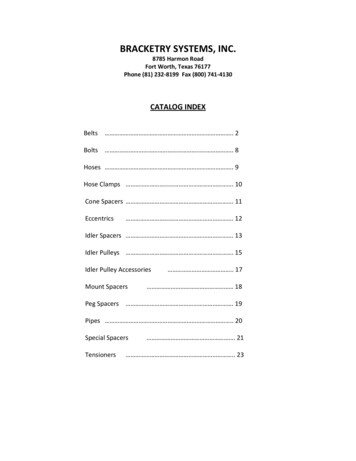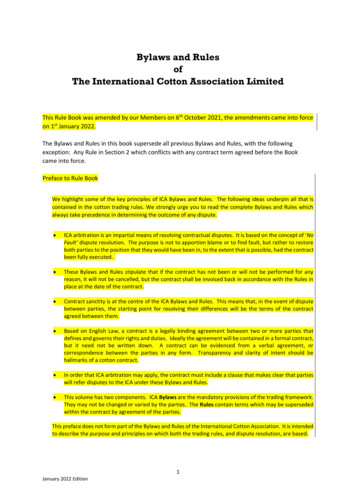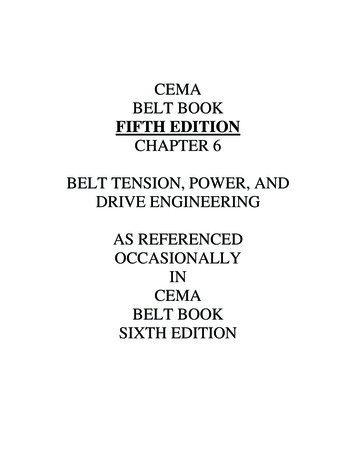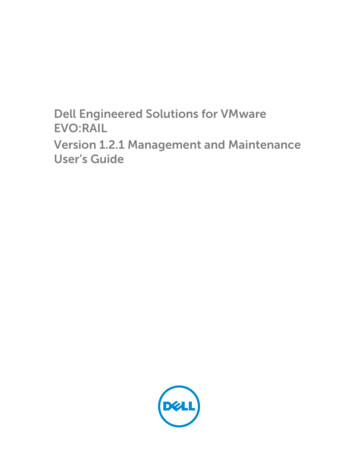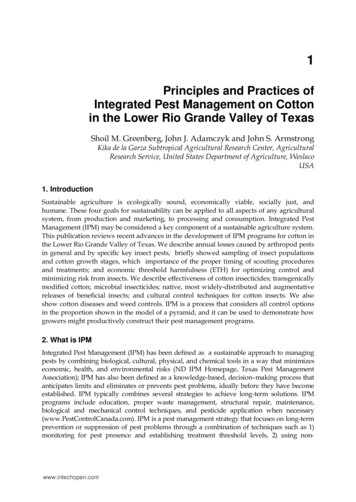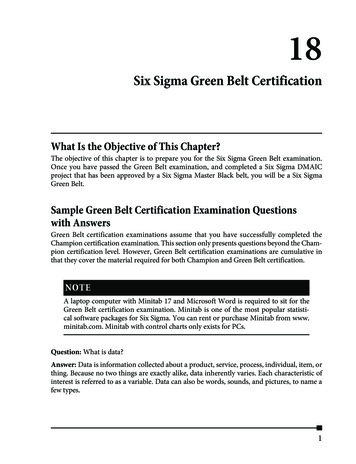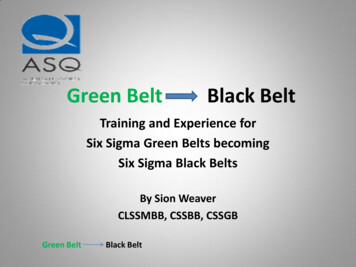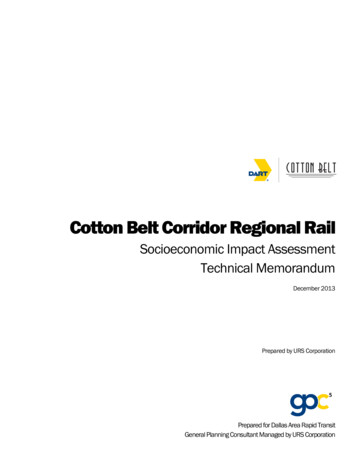
Transcription
Cotton Belt Corridor Regional RailSocioeconomic Impact AssessmentTechnical MemorandumDecember 2013Prepared by URS CorporationPrepared for Dallas Area Rapid TransitGeneral Planning Consultant Managed by URS Corporation
Document Revision RecordProject/Report Name: Socioeconomic ImpactAssessmentPM: Dan MeyersRevision Number:Version 1Version 2URS Project Number: 25338842PIC: Jerry SmileyDate:September 3, 2013Originator:Amber Majefski, AICP, URSSeptember 3, 2013Comments by:Nancy Stavish, AICP, URSReggie Herman, AICP, URSSeptember 7, 2013December 23, 2013Task Manager Approval:Date:Verified/Approved by:Date:DistributionNameTitleFirm
Cotton Belt Corridor Regional Rail ProjectTABLE OF CONTENTSTABLE OF CONTENTS . i1.0INTRODUCTION . 12.0IMPACT ASSESSMENT METHODOLOGY . 13.0IMPACT ASSESSMENT . 23.1Long-Term Effects. 23.1.1Base Alternative. 23.1.2Cypress Waters Alternatives .123.1.3North Dallas Profile Options .133.1.4Red Line Interface Alternatives .143.2Short-Term Construction Effects .153.2.1Base Alternative.163.2.2Cypress Waters Alternatives .163.2.3North Dallas Profile Options .163.2.4Red Line Interface Alternatives .174.0MITIGATION OPTIONS .18Socioeconomic Impact Assessmenti
Cotton Belt Corridor Regional Rail Project1.0 INTRODUCTIONThis Technical Memorandum assesses the socioeconomic impacts associated with the proposedCotton Belt Regional Rail Project (Cotton Belt Project). The assessment begins with a descriptionof potential impacts resulting from the Base Alternative, which would utilize the existing CottonBelt Railroad right-of-way (Cotton Belt Corridor). Subsequent sections list the specific impactsthat could result from alternative alignments and profile options.For each alignment section, potential impacts to socioeconomic resources have been discussedaccording to the following topical areas: Community Facilities Neighborhood Integrity and Community Cohesion Schools Demographics Employment Economic Development2.0 IMPACT ASSESSMENT METHODOLOGYThis section describes the methodology for determining impacts to socioeconomic resources. Allcommunity facilities and major employers immediately adjacent to the Cotton Belt Corridor oraffected by proposed alternative alignments or station areas were evaluated for potentialimpacts. In addition, school zones, neighborhoods, and homeowners associations which spanthe Cotton Belt Corridor were also evaluated for possible impacts.An adverse impact would occur if any potential disruption in activity is anticipated. This includesthe displacement of a community facility or employer, disruption to the cohesion of aneighborhood, or increased difficulty in accessing a particular facility.Socioeconomic Impact Assessment1
Cotton Belt Corridor Regional Rail Project3.0 IMPACT ASSESSMENTThe evaluation of potential socioeconomic impacts is divided into long-term effects of theproposed project and short-term, construction impacts.3.1Long-Term EffectsThe majority of the proposed Cotton Belt Project would follow the Cotton Belt Corridor. TheBase Alternative describes the potential socioeconomic impacts associated with increased travelalong Cotton Belt Corridor, as well as the effects of new station areas serving commuter rail.Potential alternatives would require new track outside of the Cotton Belt Corridor. There aretwo Cypress Waters Alternatives in Coppell that would deviate from the existing Cotton BeltCorridor, as well as a two Red Line Interface Alternatives for connecting to the DART Red Line inRichardson. Any additional impacts resulting from these alternative alignments will be discussedin the following sections.In the North Dallas area, there are design options known as the Trenching and Tunnel ProfileOptions. The potential socioeconomic impacts of these profile options are also discussed in thefollowing sections.3.1.1 Base AlternativeThe Base Alternative would follow the Cotton Belt Corridor, with station areas developed atDFW North, Downtown Carrollton, Addison, Knoll Trail Drive, Preston Road, Renner Village,UTD/Synergy Park, and at 12th Street in Plano. The following section describes potential adversesocioeconomic impacts that would occur as a result of the Base Alternative.Community FacilitiesFor purposes of this analysis, community facilities include day care centers, medical facilities,places of worship, public offices, parks, police and fire stations, schools, universities andcolleges, and other places of interest. A total of 71 community facilities were identified withinthe project study area as part of the Socioeconomic Characteristics Existing Conditions TechnicalMemorandum. Of those identified, only 19 are adjacent to the proposed Base Alternative orstation areas. A majority of these facilities are already adjacent to the existing Cotton BeltCorridor and are not considered to be negatively impacted by the project. Table 3-1 belowidentifies community facilities adjacent to or otherwise impacted by the Base Alternative. Themap key listed in the table refers to the facility’s location on Figure 4-2 from the SocioeconomicCharacteristics Existing Conditions Technical Memorandum.Impacts due to noise are described in more detail in the Noise and Vibration Impact AssessmentTechnical Memorandum. The majority of these would be mitigated through the implementationof quiet zones.Table 3-1Community Facilities Adjacent to Baseline Cotton Belt AlignmentSocioeconomic Impact Assessment2
Cotton Belt Corridor Regional Rail ProjectMapFacility NameKey12345791118232425293031336061626365Fire Station No. 121Coppell Fire DepartmentOffice of AdministrativeServices and Fire InspectionAnimal Services andAdoption CenterCoppell Road Service CenterW.W. Pinkerton ElementaryValley Ranch Baptist ChurchThe North ChurchMiracle TabernaclePentecostal Church of GodHilltop Memorial ParkTed Polk Middle SchoolKelly Athletic FieldsIslamic Association ofCarrolltonFairhill School andDiagnostic CenterCongregation Ohev Shalom/Far North Dallas EruvMontessori School atHillcrestFrankford Middle SchoolWorkforce Solutions NorthCentral TexasUS Post OfficeSmall Miracles Day CareCollinwood Nursing andRehabilitation66God's Food PantrySalvation Army - PlanoCorps67Shiloh Center (PISD Facility)AddressCityDescription of Impact520 Southwestern Blvd.CoppellNone, Adjacent to ROW500 Southwestern BlvdCoppellNone, Adjacent to ROW821 S. Coppell Rd.CoppellNone, Adjacent to ROW816 S. Coppell Rd.260 Southwestern Blvd.1501 E. Belt Line Rd.1615 Belt Line Rd.CoppellCoppellIrvingCarrolltonNone, Adjacent to ROWNone, Adjacent to ROWModerate Noise ImpactModerate Noise Impact1107 Jackson Street1810 Perry Rd.2001 Kelly Blvd.CarrolltonCarrolltonCarrolltonSevere Noise ImpactSevere Noise ImpactModerate Noise Impact2000 Kelly Blvd.Carrollton1901 Kelly Blvd.CarrolltonNone, Adjacent to ROWNone, Adjacent to ROWSevere Noise Impact15150 Preston Rd.DallasNone, Adjacent to ROW6821 McCallumDallas6950 McCallum Blvd.7706 Osage PlazaParkwayDallasSevere Noise ImpactNone, Adjacent to ROWSevere Noise ImpactDallasSevere Noise Impact1101 Resources Dr.1200 Jupiter Rd.PlanoPlanoNone, Adjacent to ROWNone, Adjacent to ROW2700 S. Rigsbee Dr.PlanoNone, Adjacent to ROW3100 S. Rigsbee Dr.3420 E. 14th St., #100and #101PlanoNone, Adjacent to ROWPlanoNone, Adjacent to ROW3528 E. 14th St.PlanoNone, Adjacent to ROW3540 14th St.PlanoNone, Adjacent to ROW68Islamic Academy1251 Shiloh Rd.PlanoNone, Adjacent to ROW6970Forman ElementarySehion Mar ThomaChurchDFW Fire – EMS Station #63600 Timberline Dr.3760 14th St.PlanoPlanoStationStation and Alignment711 RegentBoulevardGrapevine Alignment71Socioeconomic Impact Assessment3
Cotton Belt Corridor Regional Rail ProjectNeighborhood Integrity and Community CohesionThe vast majority of neighborhoods surrounding the Cotton Belt Corridor developed around therailroad, since the corridor pre-dates modern residential developments. As a result, the corridorserves as a logical physical boundary line for many neighborhoods. Only three neighborhoodshave been identified which are bisected by the existing Cotton Belt Corridor: Old Downtown Carrollton Association Preston Trail in North Dallas Highlands of McKamy in North DallasThe addition of regional rail traffic on the Cotton Belt Corridor may negatively impactneighborhood cohesion in these areas. The Old Downtown Carrollton Association is located in awell-developed area whose downtown neighborhood character is fitting with rail operations.Only a small portion of the Preston Trail neighborhood, accounting for the intersection ofPreston and Keller Springs Road, crosses the existing Cotton Belt Corridor. Therefore thepotential impact to these two neighborhoods is very minimal. The Highlands of McKamyneighborhood is a residential neighborhood directly bisected by the Base Alternative. The OldDowntown Carrollton Association already experiences some level of interruption due to theexisting freight rail corridor. The two neighborhoods in north Dallas would currently experienceno interruption due to abandoned freight service in 2010 along this portion of the Cotton BeltCorridor. The adverse impact would be related to the increased frequency of traffic along therail corridor.North Dallas EruvThe Cotton Belt Project has the potential to affect the North Dallas Jewish community if thebreaks occur in the Eruv boundary. The Cotton Belt Corridor crosses Davenport, Hillcrest,McCallum, Meandering Way, Dickerson and Coit Roads, and the proposed changes with theimplementation of the Cotton Belt Project may necessitate changes in the configuration ofutility poles, which the Jewish community uses for the Eruv. These potential changes, as well asthe potential construction of walls, fences or other structures or removal of vegetationassociated with the proposed rail alignment may impact the Eruv either positively or negatively.Temporary impacts could occur during construction if markers are down causing a break in whatis to be a continuous boundary. The Eruv must remain in good repair to be effective and with nobreaks.SchoolsThe Cotton Belt Corridor predates the development of most schools in this area. As a result,many school attendance zones along the Cotton Belt Corridor use it as a logical boundary.However, some school attendance zones are intersected by the Cotton Belt Corridor, resulting ina potential impact. Table 3-2 lists schools which have attendance zones that span the CottonBelt Corridor and approximates the amount of residential land area that would be separatedfrom the school by the Cotton Belt Corridor. The table also includes a summary of thewalkability characteristics for affected neighborhoods (those located across the proposedalignment from their designated schools).Socioeconomic Impact Assessment4
Cotton Belt Corridor Regional Rail ProjectTable 3-2Schools Attendance Zones Crossing the Cotton Belt AlignmentSchoolW.W. PinkertonElementaryBarbara S. AustinElementaryMockingbirdElementaryCoppell MiddleSchool EastCoppell MiddleSchool y PlaceElementaryBush Middle SchoolPerry Middle SchoolPolk Middle SchoolRanchview HighSchoolNewman Smith HighSchoolGeorge HerbertWalker BushElementaryE.D. Walker MiddleSchoolW.T. White rea AcrossCorridorCoppell ISD75-100%Coppell ISD0-25%Coppell ISD0-25%Coppell ISD0-25%Coppell ISDCarrollton/FarmersBranch ISDCarrollton/FarmersBranch ISDCarrollton/FarmersBranch ISDCarrollton/FarmersBranch ISDCarrollton/FarmersBranch ISDCarrollton/FarmersBranch ISDCarrollton/FarmersBranch ISDCarrollton/FarmersBranch allas ISD0-25%Dallas ISD0-25%Dallas ISD0-25%Richardson ISD25-50%Parkhill Junior HighRichardson ISD0-25%Pearce High SchoolRichardson ISD0-25%Jackson ElementaryPlano ISD0-25%Aldridge ElementaryPlano ISD0%Socioeconomic Impact AssessmentDescription of Walk/BikeAccess from AcrossTracksNearby neighborhoods, nomajor barriers to walkingNo Direct Access Available,over 2.5 miles from schoolNo Direct Access Available,over 2.0 miles from schoolNo Direct Access Available,over 2.0 miles from schoolAffected Neighborhoods areover 1.5 miles from school1.0-1.5 miles to nearestaffected neighborhoodNearby neighborhoods, nomajor barriers to walkingN/A0.5-1.0 miles to nearbyapartment complexesNearby neighborhoods, nomajor barriers to walking0.5-1.0 miles to nearbyapartment complexesOver 3.0 miles to nearestaffected neighborhood1.0-1.5 miles to nearestaffected neighborhoodsNo Direct Access Available,over 3.0 miles from schoolNo Direct Access Available,over 3.0 miles from schoolNo Direct Access Available,over 3.0 miles from schoolNearby neighborhoods, nomajor barriers to walkingNearby neighborhoods, nomajor barriers to walkingOver 2.0 miles to nearestaffected neighborhoodOver 2.0 miles to nearestaffected neighborhoods,separated by PGBTN/APotentialforImpactYesNot LikelyNot LikelyNot LikelyNot LikelyYesYesNot LikelyYesYesYesNot LikelyNot LikelyNot LikelyNot LikelyNot LikelyYesYesNot LikelyNot LikelyNot Likely5
Cotton Belt Corridor Regional Rail ProjectTable 3-2Schools Attendance Zones Crossing the Cotton Belt tialArea AcrossCorridorPlano ISD50%Forman ElementaryFrankford MiddleSchoolPlano ISD0%Plano ISD0-25%Wilson Middle SchoolPlano ISD0-25%Otto Middle SchoolArmstrong MiddleSchoolPlano ISD0-25%Plano ISD0%Shepton High SchoolPlano ISD0-25%Vines High SchoolPlano ISD0-25%Williams High SchoolPlano West Sr. HighSchoolPlano ISD0-25%Plano ISD0-25%Plano Sr. High SchoolPlano ISD0-25%Description of Walk/BikeAccess from AcrossTracksPotentialforImpactOver 2.5 miles to nearestaffected neighborhoods,separated by PGBTNot LikelyN/A0.5-1.0 miles to nearbyapartment complexes1.5 to 2.0 miles to nearestaffected neighborhoods,separated by PGBTOver 2.5 miles to nearestaffected neighborhoodsN/AOver 3.5 miles to nearestaffected neighborhoods,separated by PGBTOver 2.0 miles, separatedby PGBTOver 2.0 miles, separatedby PGBTOver 5 miles, separated byPGBTOver 2.5 miles, separatedby PGBTNot LikelyYesNot LikelyNot LikelyNot LikelyNot LikelyNot LikelyNot LikelyNot LikelyNot LikelyAlthough the attendance zones for Country Place Elementary, Aldridge Elementary, FormanElementary, and Armstrong Middle school do span the existing Cotton Belt Corridor, noresidential areas exist across the tracks from the school. Therefore no impact to schoolaccessibility is anticipated.For many schools along the corridor, the neighborhoods separated by the proposed BaseAlternative are also separated from their schools by long distances or other barriers, makingnon-motorized school access unlikely. Neighborhoods more than one mile from a school,separated by a major transportation facility, or disconnected by neighborhood design were notconsidered walkable. For this reason, the majority of schools in Table 3-2 would not be likely toexperience any adverse impact to walking or bike access as a result of the base alternative.A few schools in Table 3-2 would be minimally impacted. In Coppell ISD, Pinkerton Elementary islocated south of the Cotton Belt Corridor as shown in Figure 3-1. The neighborhoods north ofthe Cotton Belt Corridor are close enough to the elementary school that walking or biking toschool is likely to occur, especially because no major roadways create barriers to non-motorizedtravel. Students can cross the existing Cotton Belt Corridor in two locations: east of the schoolalong Coppell Road or west of the school on Denton Tap Road. The increase in rail traffic couldSocioeconomic Impact Assessment6
Cotton Belt Corridor Regional Rail Projectimpede walking access to the school. However, students and parents are already accustomed tofreight rail traffic along this portion of the Cotton Belt Corridor and both crossings are alreadyequipped with flashing light signals and gates, so the potential impacts would be minimal.Figure 3-1Riverchase Elementary and Barbara Bush Middle School are located in Carrollton/FarmersBranch ISD west of IH 35 as depicted in Figure 3-2. Several neighborhoods and apartmentcomplexes are located within walking distance of both schools, making pedestrian and bikeaccess likely. The primary mode of access for the schools is along MacArthur Boulevard. TheBase Alternative would increase rail traffic along the Cotton Belt Corridor, which could impactstudents who chose to walk or bike. The rail crossing at MacArthur Road has flashing lightsignals, gates and a traffic control signal regulating vehicle and pedestrian movements acrossBelt Line Road, which should help to minimize most of the impact.Also in Carrollton/Farmers Branch ISD, to the east of IH 35, Carrollton Elementary and PerryMiddle School are located off of Perry Road south of the existing Cotton Belt Corridor.Residential area just north and is within walking distance of both schools and likely to generatesome pedestrian and bike travel. The most direct access to these neighborhoods occurs alongPerry Road. Perry Road currently has a flashing signal and gate at the Cotton Belt Corridor;however, there is no designated pedestrian path to utilize for crossing. Increased rail trafficresulting from the Base Alternative could create an adverse impact related to school access inthis area.Socioeconomic Impact Assessment7
Cotton Belt Corridor Regional Rail ProjectFigure 3-2Figure 3-3Polk Middle school in Carrollton/Farmers Branch ISD is located north of the Cotton Belt Corridoron Kelly Lane, as show in Figure 3-4. The majority of property south of the corridor iscommercial; however, one block, located south of Country Club Drive between Josey Lane andMetrocrest Drive, is residential. Students in this area are close enough to walk or bike to schooland could be adversely impacted by the increased rail traffic. Access to the school would requirecrossing the on Kelly Boulevard. This crossing is currently equipped with flashing signals, gates,and a designated pedestrian crossing. Any potential adverse impacts are expected to affect onlya small number of students, as the affected residential area is quite small.Figure 3-4Socioeconomic Impact Assessment8
Cotton Belt Corridor Regional Rail ProjectBrentfield Elementary and Parkhill Junior High in the Richardson ISD are located adjacent toeach other, southeast of the Cotton Belt Corridor, as shown in Figure 3-5. Both schools’attendance zones include the nearby neighborhoods on the northeast side of the existing tracks.Students from these neighborhoods could access school from the southern Davenport Roadcrossing, along Campbell Road, or via the northern Davenport Road crossing. All three crossingsare currently appointed with flashing signals, gates, and a pedestrian crossing, which wouldminimize the potential impact due to increased rail traffic along Cotton Belt Corridor.Figure 3-5In the Plano ISD, Frankford Middle School is located north of the Base Alternative on OsagePlaza, as indicated on Figure 3-6. A small portion of this school’s attendance zone lies south ofthe Cotton Belt Corridor, extending east to Coit Road and south to the apartment buildings onthe southern side of McCallum Road. The most direct access across is along Dickerson Road;however, some students may also cross at Meandering Way or Coit Road. Meandering Way andCoit Road have existing flashing signals, gates, and pedestrian crossings. The Dickerson StreetCrossing, however, does not. Students using this route to access Frankford Middle School maybe adversely impacted by the increase of rail traffic resulting from the Base Alternative.Socioeconomic Impact Assessment9
Cotton Belt Corridor Regional Rail ProjectFigure 3-6DemographicsIt is possible that the addition of regional rail service could result in a slight change to theexisting demographics in this area. However no negative impacts are anticipated as a result ofthe Base Alternative.EmploymentMajor employers, or businesses with 250 or more employees, are identified by the NorthCentral Texas Council of Governments (NCTCOG). A total of 40 major employers were identifiedas part of the Socioeconomic Characteristics Existing Conditions Technical Memorandum. Ofthese, almost half would be within walking distance of a proposed station and would receivebenefit from having access to a rail station.Table 3-3 below lists the 13 major employers which are adjacent to the proposed BaseAlternative. None of these are expected to be adversely impacted as they are already adjacentto the Cotton Belt Corridor. No improvements or proposed station areas outside the existingCotton Belt Corridor right-of-way would infringe on these properties.Socioeconomic Impact Assessment10
Cotton Belt Corridor Regional Rail ProjectTable 3-3Major Employers Adjacent to Proposed Baseline AlternativeEmployerHaverty'sU.S. Postal ServiceGE AutomationServicesAT&TCushman & Wakefieldof Texas, Inc.BombardierHewlett-PackardIntervoice, Inc.TriquintSemiconductorTexas InstrumentsAddress770 Gateway Blvd.Coppell, TX 75019951 W. Bethel Rd.Coppell, TX 750192025 W. Beltline Rd.Carrollton, TX 7500615660 Dallas Pkwy., Ste. 100Dallas, TX 7524815455 Dallas Pkwy., Ste. 800Addison, TX 750013400 Waterview Pkwy.Richardson, TX 750803000 Waterview Pkwy.Richardson, TX 7508017811 Waterview Pkwy.Dallas, TX 75252500 W. Renner Rd.Richardson, TX 75080300 W. Renner Rd.Richardson, TX 75080General CableIndustries, Inc.900 Avenue FSamsung Telecom.America1000 Klein Rd.Magnetic Data Texas,LLC2901 Technology Dr., Ste. 101Plano, TX 75074Plano, TX 75074Plano, TX 75074EmploymentDescription of ImpactRange250-499Adjacent to Alignment1000-2499Adjacent to Alignment500-999Adjacent to Alignment500-999Adjacent to Alignment250-499Adjacent to Alignment250-4991000-2499Adjacent to Alignment andUTD/Synergy Park stationAdjacent to Alignment andUTD/Synergy Park station500-999Adjacent to Alignment500-999Adjacent to Alignment250-499Adjacent to Alignment250-499Adjacent to Alignment500-999250-499Adjacent to Alignment andShiloh Road StationAdjacent to AlignmentAdditionally, State Farm Insurance is currently constructing a new 1.5-million square foot facilitythat could house 6,500 employees adjacent to the Bush Turnpike Station on the Red LineInterface South Alternative. The existing Bush LRT Station is situated between the newdevelopment and the proposed Cotton Belt Station. No adverse impact to the State Farmdevelopment will result from the Cotton Belt Project.Economic DevelopmentThe addition of regional rail service could result in an impact to economic development alongthe corridor. Some existing DART station areas have spawned an increase in transit-orientedSocioeconomic Impact Assessment11
Cotton Belt Corridor Regional Rail Projectdevelopment. No negative economic development impacts are anticipated as a result of theBaseline Alternative.3.1.2 Cypress Waters AlternativesTwo alternative alignments are under study in Section 1, near North Lake and the plannedCypress Waters mixed use development. Both alternatives would include the addition of theNorth Lake Station on the northwest side of the proposed rail alignment.Cypress Waters Southwestern Boulevard AlternativeThis alternative begins at South Coppell Road as a single track alignment on new location andveers to the southeast, generally following Southwestern Boulevard and relocated Belt LineRoad. It is on an aerial structure over Grapevine Creek and is grade separated at South DentonTap Road with an aerial structure. The alternative then descends to at grade and turns northeastto rejoin the existing Cotton Belt Corridor at Moore Road.Two community facilities are located near the Cypress Waters Southwestern BoulevardAlternative: W.W. Pinkerton Elementary at 260 Southwestern Boulevard and Riverside Churchof Christ at 150 E. Belt Line Road in Coppell. The proposed alignment would not directly impacteither facility. However, there could be a slight impact on the accessibility of these facilities,which are both located off of Southwestern Boulevard/Belt Line Road, to the north side of thestreet. The aerial structure spanning Grapevine Creek could be extended across to the southside of Southwestern Boulevard in order to avoid access issues at W.W. Pinkerton Elementary.East of Denton Tap Road, however, this alternative runs in the median of Belt Line Road, whichcould limit turning access into and out of the church. In addition, the W.W. Pinkertonelementary school has been identified as a potential severe noise impact. Noise impacts aredescribed in more detail in the Noise and Vibrations Impact Assessment TechnicalMemorandum. The majority of these would be mitigated through the implementation of quietzones.The majority of the attendance zone for W.W. Pinkerton Elementary is located to the north ofthe school and north of the existing Cotton Belt Corridor. This alternative, which would reroutethe rail alignment south around the school would actually result in an improvement to theschool’s neighborhood connectivity. Instead of 75-100% of the residential area in the school’sattendance zone being located across the Cotton Belt Corridor, as indicated above in Table 3-2,this alternative would result in only 0-25% separated by the tracks. Although an adverse impactwould occur for the neighborhoods to the south, the overall impact for the school would bepositive.No neighborhoods, homeowners associations, or major employers are directly impacted by theCypress Waters Southwestern Boulevard Alternative. Any demographic or economicdevelopment impacts which may occur as a result of the North Lake Station would beconsidered neutral to positive.Cypress Waters South AlternativeThe Cypress Waters South Alternative begins at South Coppell Road as a single track alignmenton new location and veers to the southeast, similar to the Southwestern Boulevard Alternative;however, this alternative is located south of Southwestern Boulevard and Belt Line Road. It is onSocioeconomic Impact Assessment12
Cotton Belt Corridor Regional Rail Projectan aerial structure over Grapevine Creek and is grade separated at South Denton Tap Road withan aerial structure. The Alternative then descends to at grade and turns northeast to rejoin theexisting Cotton Belt Corridor at Moore Road.The two community facilities described for the Southwestern Boulevard Alternative above,W.W. Pinkerton and Riverside Church of Christ, are also in proximity to this alignmentalternative. The aerial structure at Grapevine Creek would occur further to the south,simultaneously crossing Southwestern Boulevard and eliminating any impact to the school. Noadverse impacts would occur at the church either, as here the proposed rail alignment wouldrun approximately 500 feet south of Belt Line Road.The same overall positive impact described above is anticipated for the W.W. PinkertonElementary School attendance zone. No neighborhoods, homeowners associations, or majoremployers are directly impacted by the Cypress Waters Southwestern Boulevard Alternative.Any demographic or economic development impacts which may occur as a result of the NorthLake Station would be considered neutral to positive.3.1.3 North Dallas Profile OptionsThree profile options are under consideration through a 2.6 mile section between Preston Roadand Meandering Way in the North Dallas area. All three profile options would follow the samerail alignment (Base Alternative), along the Cotton Belt Corridor, with the only differences beingthe amount of land required to create the necessary bridge structures and retaining walls.At-Grade Profile Option (Section 3-2A)This profile option would operate at-grade through North Dallas and would use bridges at thethree creek crossings locally known as McKamy Branch, Osage Branch Crossing #1 and OsageBranch Crossing #2. The profile option would continue at-grade crossing the roadways ofDavenport Road (twice), Campbell Road, Hillcrest Road, McCallum Boulevard, and MeanderingWay.The Base Alternative includes the At-Grade Profile Option; therefore, the impacts for this profileoption would be the same for those described under the Base Alternative.The Highlands of McKamy neighborhood spans this portion of the profile option. However, sincechanges to existing horizontal and vertical alignments are minimal, no adverse impact tocommunity cohesion is anticipated.School attendance zones which cross the proposed rail alignment profile optoin in this areainclude Brentwood Elementary School, Parkhill Junior High, and Pearce High School inRichardson ISD as well as Jackson Elementary, Frankford Middle School, and Shepton HighSchool in
33 Frankford Middle School 7706 Osage Plaza Parkway Dallas Severe Noise Impact 60 . 62 Small Miracles Day Care 2700 S. Rigsbee Dr. Plano None, Adjacent to ROW 63 Collinwood Nursing and Rehabilitation 3100 S. Rigsbee Dr. Plano None, Adjacent to ROW . many school attendance zones along the Cotton Belt Corridor use it as a logical boundary.
